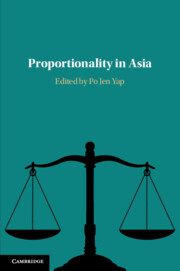Book contents
- Proportionality in Asia
- Proportionality in Asia
- Copyright page
- Contents
- Figures
- Tables
- Contributors
- Acknowledgments
- Abbreviations
- Introduction
- Part I Structured Proportionality
- Part II Anemic / Ad Hoc Proportionality
- Part III Doctrinal Equivalents of Proportionality
- 9 Reasonableness as Proportionality
- 10 Importing Proportionality through Legislation
- Conclusion
- Index
10 - Importing Proportionality through Legislation
A Philippine Experiment
from Part III - Doctrinal Equivalents of Proportionality
Published online by Cambridge University Press: 18 September 2020
- Proportionality in Asia
- Proportionality in Asia
- Copyright page
- Contents
- Figures
- Tables
- Contributors
- Acknowledgments
- Abbreviations
- Introduction
- Part I Structured Proportionality
- Part II Anemic / Ad Hoc Proportionality
- Part III Doctrinal Equivalents of Proportionality
- 9 Reasonableness as Proportionality
- 10 Importing Proportionality through Legislation
- Conclusion
- Index
Summary
Philippine courts do not use a multi-step proportionality test in their constitutional rights analyses. Instead, they use a combination of balancing and tiers-of-rights analyses. We offer two reasons why Philippine courts do not use the proportionality test. First, Philippine courts regard US constitutional law as more persuasive authority than other foreign jurisprudence, and the proportionality test is also absent from the U.S. Reports. Second, Philippine constitutionalism is originalist, and proportionality is not part of the original meaning of the Philippine Constitution. The Philippine Data Privacy Act of 2012 can be interpreted as the legislative empowerment of courts to use the proportionality test for the adjudication of data privacy rights. We argue that Philippine Congress has the power to mandate the use of the test with respect to constitutional rights that are subject to Legislative Delimitation Provisos, which give Congress the power to determine, by statute, the limits or boundaries of certain constitutional rights, including the right to informational privacy. We propose a two-step process in adjudicating informational privacy cases which would retain the judicial use of legal categories while concurrently introducing proportionality stricto sensu. This will offer a structured, transparent approach to the constitutional adjudication of data privacy rights.
- Type
- Chapter
- Information
- Proportionality in Asia , pp. 242 - 266Publisher: Cambridge University PressPrint publication year: 2020

